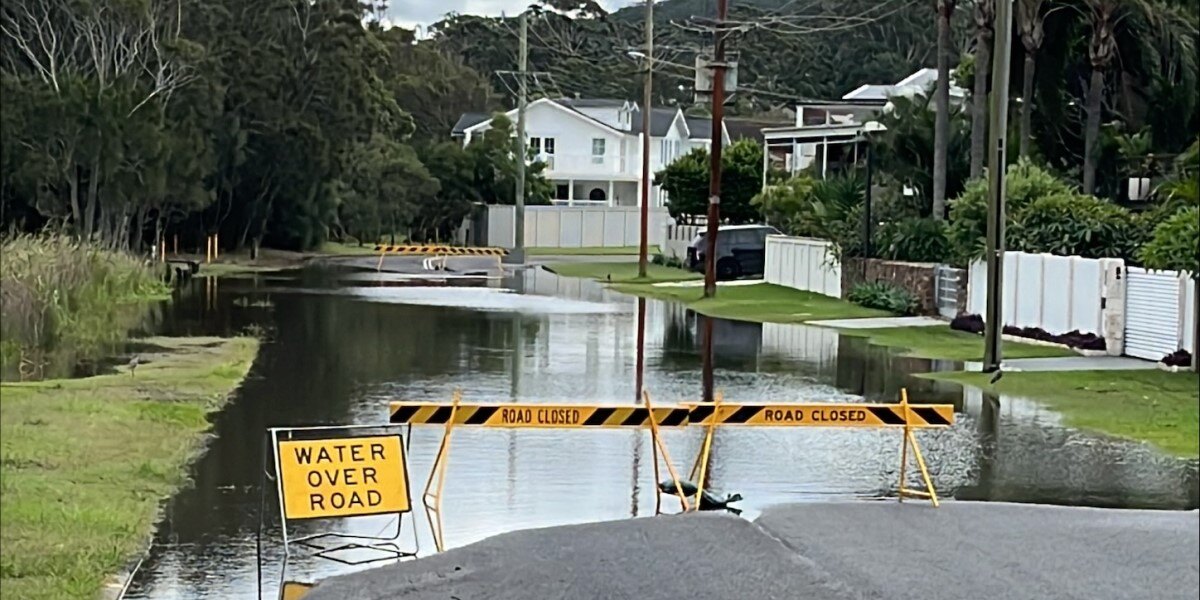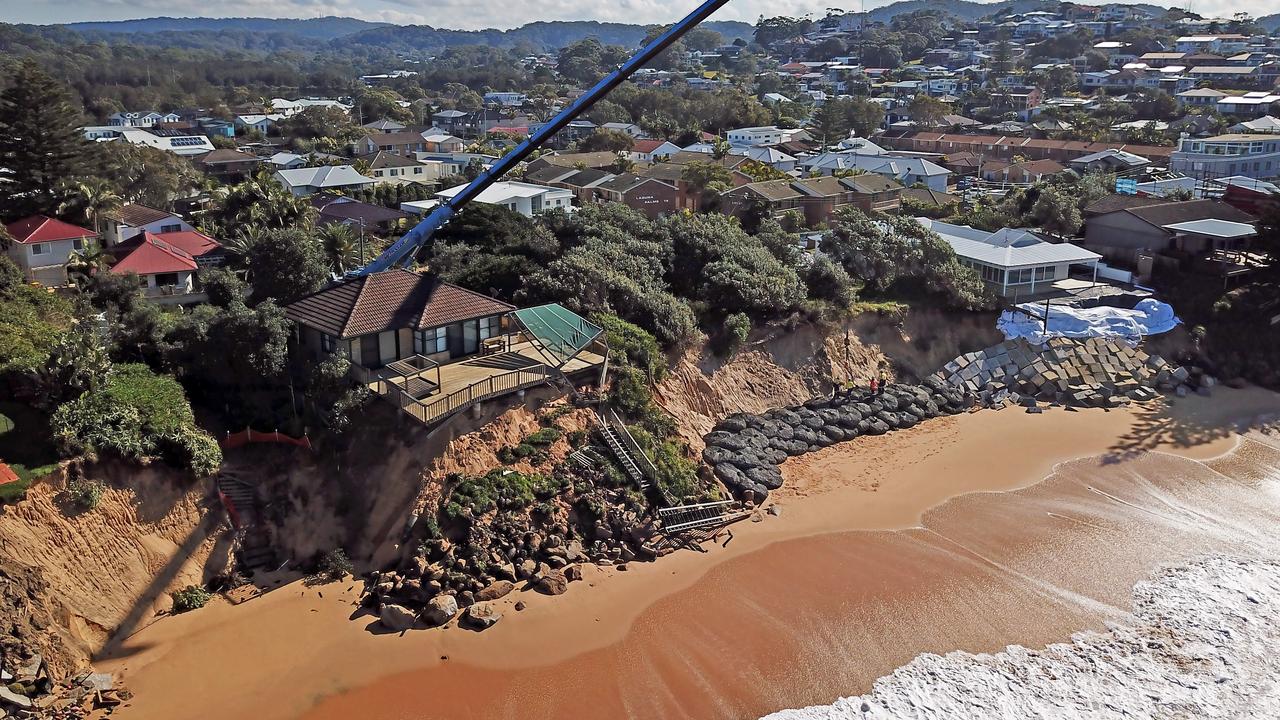Coastal Erosion on the Central Coast
Coastal erosion is a natural process that affects many parts of the Central Coast. It occurs when waves, tides, currents and wind gradually wear away the shoreline. While erosion is part of a dynamic coastal system, it can threaten public and private assets such as roads, parks, homes and infrastructure – particularly during storms or periods of high wave activity.
Understanding the Issue
The Central Coast features over 80 kilometres of open coastline and many estuarine beaches and headlands. These areas are constantly shaped by natural coastal processes. While some erosion is normal, climate change, rising sea levels, and increased storm frequency are expected to worsen the problem, placing additional pressure on already vulnerable areas. Certain locations across the Central Coast experience persistent or severe erosion and managing this is a complex challenge requiring both immediate response and long-term planning.
Council’s Role and Responsibility
Central Coast Council plays a key role in managing coastal hazards, guided by the NSW Coastal Management Act 2016 and associated state policies. While Council is not responsible for protecting private property, it does have responsibilities for managing public land, protecting community assets, supporting public safety, and helping coordinate long-term coastal management efforts.
What is Council Doing?
Council is taking proactive steps to reduce the impacts of coastal erosion and plan for the future of our beaches and coastal communities. Current activities include:
• Monitoring coastal change, including beach erosion and shoreline movement, using aerial drone and satellite imagery, field surveys and expert studies
• Maintaining public infrastructure, such as beach accessways, pathways and seawalls in erosion-affected areas
• Developing Coastal Management Programs (CMPs) that identify risks and guide short- and long-term actions
• Engaging with local residents, First Nations communities, coastal users and government agencies to shape coastal planning and priorities
• Coordinating emergency response planning in high-risk areas
• Seeking state and federal funding for coastal protection and management projects
• Undertaking nature-based solutions, like dune restoration and vegetation planting
• Reviewing land use planning policies to help avoid and reduce future erosion risk to development

Exploring Potential Solutions
There is no single solution to managing coastal erosion. A combination of approaches is often required depending on the level of risk, local conditions, and community values. Two common approaches often discussed across the Central Coast are terminal protection and sand nourishment:
1. Terminal Protection (Seawalls)
Seawalls and other terminal protection structures can offer an effective last line of defence in areas where coastal erosion poses a significant threat to public and private assets. On the Central Coast, any consideration of terminal protection is based on rigorous engineering standards and coastal planning requirements.
Key design principles include:
• Locating structures as far landward as possible to reduce interaction with coastal processes and preserve natural beach amenity
• Placing structures on private land, where appropriate, with costs typically funded by private property owners
• Burying the structure beneath the dune, so it remains invisible under normal conditions and is only exposed in severe erosion events
• Minimising the need for ongoing sand nourishment or structural maintenance
• Ensuring designs use materials and forms that blend with the natural environment and avoid excessive visual impact
Properly implemented terminal protection reduces the need for costly, reactive emergency works—such as the unsightly and temporary placement of rock or other materials ordered during state-led emergency responses. These short-term fixes are often publicly funded, not designed for long-term use, and can impact beach amenity. Well-designed terminal protection helps safeguard infrastructure and reduce public costs, while supporting a more sustainable and coordinated coastal management strategy. Learn more at our Wamberal Beach Coastal Erosion page
2. Sand Nourishment
Sand nourishment involves placing sand on a beach to temporarily restore width and buffer wave action. While it can improve amenity and support ecological processes, sand nourishment alone is not a reliable form of protection during extreme weather.
This approach typically involves transporting compatible sand from another location and placing it on the beach to rebuild its width and volume. While it can help preserve recreational use and beach aesthetics, it comes with significant technical, regulatory, environmental, and financial challenges, including:
• Strict licensing requirements under the NSW Mining Act, which treats sand as a regulated mineral resource
• Limited availability of suitable sand sources
• Environmental impacts from dredging, including damage to marine ecosystems, surf breaks, and seafloor habitats
• Potential to smother marine organisms when sand is deposited
• Disturbance to shorebird habitats, particularly in intertidal zones
• High financial cost, often requiring millions of dollars even for modest-scale projects
• Ongoing need for repeat nourishment, especially in high-energy coastal environments like the Central Coast
In New South Wales, there is currently no established legal or regulatory pathway for offshore sand nourishment. For this method to be included in a Coastal Management Program (CMP), several critical challenges must be addressed:
Access and Licensing - Offshore sand is classified as a state-owned resource. Council would be required to:
• Apply for a Mineral Exploration Licence to locate suitable sand
• Apply for a Mineral Extraction Licence to use it
Environmental Assessment - Site-specific environmental impact studies would be required for each proposed nourishment site to evaluate potential effects on:
• Beach slope and nearshore bathymetry
• Wave dynamics and surf quality
• Intertidal and marine habitats
• Sediment transport processes
Cost Sharing and Funding
• Offshore sand nourishment is currently financially beyond Council’s capacity. A viable funding model involving state and federal contributions would be necessary before such a project could proceed.
Due to these regulatory, environmental and funding barriers, mass offshore sand nourishment is not currently a viable or approved solution on the Central Coast. However, small-scale sand placement (such as dune scraping or land-sourced trucking) may still be considered, where supported by ecological and engineering advice, and where it complements broader protection strategies.
Looking Ahead
Coastal erosion is a complex challenge that requires long-term planning, responsible decision-making, and collaboration across all levels of government and the community. Council will continue to:
• Monitor and adapt to changing coastal conditions
• Engage openly with the community
• Plan for sustainable, cost-effective solutions that protect the coastline for future generations
For more information about Council’s coastal planning and current Coastal Management Programs, visit our Coastal Management web page.

Coastal Inundation
Coastal inundation occurs when low-lying areas near the coast are temporarily flooded by elevated water levels in lagoons, estuaries, or from storm surge and heavy rainfall. This is a natural process that plays an important role in the health and function of coastal environments.
On the Central Coast, coastal inundation is common in and around our coastal lagoons and estuarine systems. Natural inundation events help sustain wetlands, deliver nutrients across the floodplain, support breeding and feeding grounds for birds and fish, and lift built-up wrack (organic matter like seaweed and seagrass) from the water’s edge—helping it decompose more naturally and reducing the need for manual removal.
However, urban development and stormwater infrastructure have altered the way water moves through our catchments. Hard surfaces, roads and pipes allow water to enter our creeks, lakes and lagoons more rapidly and in greater volumes, which can lead to more frequent and intense inundation in developed areas.
What is Council Doing?
Central Coast Council uses a mix of natural, engineered and planning-based approaches to manage inundation risks while protecting the ecological function of our coastal systems. Key actions include:
• Monitoring water levels, rainfall and tides in lagoons, estuaries and lakes
• Managing the opening of coastal lagoon entrances (e.g., Wamberal, Terrigal, Avoca and Cockrone Lagoons) through formal procedures when inundation threatens public or private land
• Implementing a separate entrance management procedure for Tuggerah Lakes to guide decisions on entrance widening during periods of high water
• Installing and maintaining Gross Pollutant Traps (GPTs), SQUIDs (Stormwater Quality Improvement Devices), and water-sensitive urban design (WSUD) features to slow runoff and reduce pollutants entering waterways
• Creating and maintaining constructed wetlands that help filter stormwater, reduce flow velocity and support biodiversity
• Restoring and protecting natural buffer zones such as wetlands, floodplains and vegetated foreshores to absorb and store excess water
• Incorporating inundation and sea level rise data into land use planning and development controls
These actions not only help reduce flood risk but also improve water quality and support the health of coastal ecosystems. Learn more about Council’s management procedures:
• Lagoon Entrance Opening Procedures
• Tuggerah Lakes Interim Entrance Management Procedure
What Can the Community Do?
Everyone has a role to play in reducing the impacts of coastal inundation. Here are a few ways you can help:
• Install rain gardens, swales or permeable paving to slow stormwater runoff
• Install water tanks to capture rain water and store it for later use
• Reduce the use of fertilisers, detergents and chemicals that can wash into waterways
• Keep stormwater drains free of leaves, rubbish and sediment
• Support and protect natural vegetation along waterways and flood-prone land
• Learn more about how your property fits into the local catchment system
By working with nature and reducing the speed and pollution of water flowing into our creeks, lagoons and estuaries, we can help protect both our communities and our coastal environments.